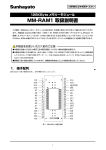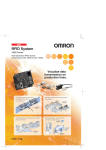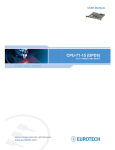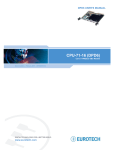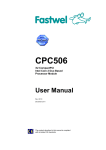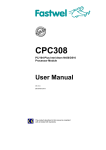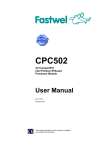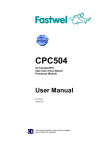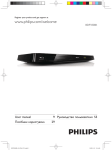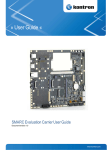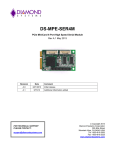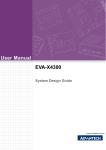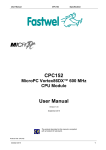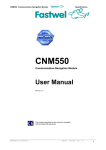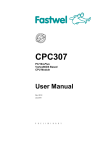Download CPB906 User Manual 001 E
Transcript
CPB906 Vortex86DX Based COM Module User Manual Rev. 001 E November 2010 P R E L I M I N A R Y Product Title: Document name: Manual version: Ref. doc. ver.: CPB906 CPB906 User Manual 001 E 1.0 R (ИМЕС.421459.906 РЭ) Copyright © 2010 Fastwel Co. Ltd. All rights reserved. Revision Record Rev. Index Brief Description of Changes Board Index Date of Issue 001 Initial version CPB906 November 2010 Contact Information Fastwel Co. Ltd Fastwel Corporation US Address: 108 Profsoyuznaya st., Moscow 117437, Russian Federation 45 Main Street, Suite 319 Brooklyn, New York 11201 USA Tel.: +7 (495) 232-1681 +1 (718) 554-3686 Fax: +7 (495) 232-1654 +1 (718) 797-0600 Toll free: E-mail: [email protected] Web: http://www.fastwel.com/ +1 (877) 787-8443 (1-877-RURUGGED) CPB906 Table of Contents Table of Contents ..............................................................................................................................................1 List of Tables .....................................................................................................................................................2 List of Figures ....................................................................................................................................................3 Notation Conventions.........................................................................................................................................4 General Safety Precautions................................................................................................................................5 Unpacking, Inspection and Handling...................................................................................................................6 Three Year Warranty..........................................................................................................................................7 1 Introduction...................................................................................................................................... 8 1.1 1.2 1.3 1.4 1.5 1.6 1.7 1.8 2 Module Introduction.................................................................................................................................8 Main Specifications .................................................................................................................................8 Functional Diagram ...............................................................................................................................11 Appearance and Layout ........................................................................................................................12 CPB906 Versions..................................................................................................................................13 Delivery Checklist..................................................................................................................................13 Additional Accessories ..........................................................................................................................14 Functional Description...........................................................................................................................14 1.8.1 Vortex86DX SoC ..................................................................................................................14 1.8.2 XS1 Main High-Dencity Connector.........................................................................................15 1.8.3 Supervisor and Watchdog Timers..........................................................................................19 1.8.3.1 WDT0 and WDT1 Registers Description ................................................................19 1.8.4 SDRAM Memory...................................................................................................................23 1.8.5 Flash BIOS...........................................................................................................................23 1.8.6 ATA Flash Disk .....................................................................................................................23 1.8.7 IDE/SDIO Port ......................................................................................................................24 1.8.8 COM1, COM2 Serial Ports ....................................................................................................24 1.8.9 PS/2 Keyboard and Mouse Interface......................................................................................25 1.8.10 RTC and Battery ...................................................................................................................25 1.8.11 USB Interface .......................................................................................................................26 1.8.12 Fast Ethernet Interface..........................................................................................................26 1.8.13 FRAM...................................................................................................................................26 1.8.14 Remote Reset/Interrupt, Remote Power Fail Signal Source Ports ...........................................26 1.8.15 8-bit ISA Port ........................................................................................................................26 1.8.16 LPC Port...............................................................................................................................26 1.8.17 PCI Port (XS1)......................................................................................................................27 1.8.18 I2C Port................................................................................................................................27 1.8.19 GPIO Port.............................................................................................................................27 1.8.20 PC-Buzzer Port.....................................................................................................................27 1.8.21 LED indicators ......................................................................................................................27 1.8.22 Redundancy Port ..................................................................................................................28 Technical Information .....................................................................................................................29 2.1 2.2 2.3 2.4 2.5 2.6 C P B 9 0 6 Hardware Interrupts...............................................................................................................................29 DMA Channels......................................................................................................................................29 I/O Addressing ......................................................................................................................................30 Memory Addressing ..............................................................................................................................31 GPIO Processor Ports...........................................................................................................................31 Overall and Mounting Dimensions .........................................................................................................32 U s e r M a n u a l 1 © 2 0 1 0 F a s t w e l v . 0 0 1 E CPB906 3 System Setup ..................................................................................................................................33 3.1 3.2 3.3 3.4 Safety Regulations ................................................................................................................................33 Jumper Settings ....................................................................................................................................34 Software Installation..............................................................................................................................34 AMI BIOS .............................................................................................................................................34 3.4.1 BIOS Setup Program. Introduction.........................................................................................34 Basic Software......................................................................................................................................35 Service Software...................................................................................................................................35 3.6.1 SPIFLASH.EXE Utility...........................................................................................................35 CPB906 Programming FAQ...................................................................................................................35 3.5 3.6 3.7 4 Appendices .....................................................................................................................................36 4.1 KIB880 Carrier Board ............................................................................................................................36 4.1.1 Introduction...........................................................................................................................36 4.1.2 Appearance and Layout ........................................................................................................36 4.1.3 Functional Diagram...............................................................................................................39 4.1.4 Specifications .......................................................................................................................39 4.1.5 Delivery Checklist .................................................................................................................41 4.1.6 External Connections ............................................................................................................41 List of Tables Table 1.1: Table 1.2: Table 1.3: Table 1.4: Table 1.5: Table 1.6: Table 1.7: Table 1.8: Table 1.9: Table 1.10: Table 1.11: Table 1.12: Table 1.13: Table 1.14: Table 1.15: Table 1.16: Table 1.17: Table 1.18: Table 1.19: Table 1.20: Table 1.21: Table 1.22: Table 2.1: Table 2.2: Table 2.3: Table 2.4: Table 2.5: Table 2.6: Table 3.1: C P B 9 0 6 U s e r CPB906 Versions .......................................................................................................................13 CPB906 Additional Accessories ..................................................................................................14 XS1: Main High-Density Connector Pinout ..................................................................................15 WDT0 Restart Register...............................................................................................................19 WDT0 Port Address Index Register.............................................................................................19 WDT0 Port Data Register ...........................................................................................................19 WDT0 Timer Control Register .....................................................................................................20 WDT0 Event Selection Register ..................................................................................................20 WDT0 Timer Value CNT0 Register .............................................................................................20 WDT0 Timer Value CNT1 Register .............................................................................................21 WDT0 Timer Value CNT2 Register .............................................................................................21 WDT0 Timer Mode Register .......................................................................................................21 WDT1 Restart Register...............................................................................................................21 WDT1 Timer Control Register .....................................................................................................22 WDT1 Event Selection Register ..................................................................................................22 WDT1 Timer Value CNT0 Register .............................................................................................22 WDT1 Timer Value CNT1 Register .............................................................................................22 WDT1 Timer Value CNT2 Register .............................................................................................23 WDT1 Timer Mode Register .......................................................................................................23 Frequency Divider Values for Serial Ports ...................................................................................25 LED Indicators............................................................................................................................27 XP1 Redundancy Connector Pinout ............................................................................................28 Interrupt Settings........................................................................................................................29 DMA Channels ...........................................................................................................................29 I/O Address Space .....................................................................................................................30 Memory Address Mapping ..........................................................................................................31 Processor GPIO Control Registers..............................................................................................31 Processor GPIO Lines Description..............................................................................................32 Jumper Positions........................................................................................................................34 M a n u a l 2 © 2 0 1 0 F a s t w e l v . 0 0 1 E CPB906 List of Figures Figure 1.1: Figure 1.2: Figure 1.3: Figure 1.4: Figure 1.5: Figure 1.6: Figure 2.1: Figure 4.1: Figure 4.2: Figure 4.3: Figure 4.4: Figure 4.5: CPB906 Block Diagram ..............................................................................................................11 CPB906 Module Appearance......................................................................................................12 CPB906 Main Components Layout .............................................................................................12 XS1 Main High-Dencity Connector ..............................................................................................15 Connection of CPB906 COM-Express Connector and the Carrier Board Counterpart....................15 Redundancy Connection.............................................................................................................28 CPB906: Overall and Mounting Dimensions ................................................................................32 KIB880 Appearance ...................................................................................................................36 KIB880 Main Components Layout: Top Side ...............................................................................37 KIB880 Main Components Layout: Bottom Side ..........................................................................38 KIB880 Block Diagram................................................................................................................39 KIB880 External Connections Diagram........................................................................................41 All information in this document is provided for reference only, with no warranty of its suitability for any specific purpose. This information has been thoroughly checked and is believed to be entirely reliable and consistent with the product that it describes. However, Fastwel accepts no responsibility for inaccuracies, omissions or their consequences, as well as liability arising from the use or application of any product or example described in this document. Fastwel Co. Ltd. reserves the right to change, modify, and improve this document or the products described in it, at Fastwel's discretion without further notice. Software described in this document is provided on an “as is” basis without warranty. Fastwel assumes no liability for consequential or incidental damages originated by the use of this software. This document contains information, which is property of Fastwel Co. Ltd. It is not allowed to reproduce it or transmit by any means, to translate the document or to convert it to any electronic form in full or in parts without antecedent written approval of Fastwel Co. Ltd. or one of its officially authorized agents. Fastwel and Fastwel logo are trademarks owned by Fastwel Co. Ltd., Moscow, Russian Federation. Ethernet is a registered trademark of Xerox Corporation. IEEE is a registered trademark of the Institute of Electrical and Electronics Engineers Inc. Intel is a trademark of Intel Corporation. Geode is trademark of AMD. Microsoft is a trademark of the Microsoft corporation. In addition, this document may include names, company logos and trademarks, which are registered trademarks and, therefore, are property of their respective owners. Fastwel welcomes suggestions, remarks and proposals regarding the form and the content of this Manual. C P B 9 0 6 U s e r M a n u a l 3 © 2 0 1 0 F a s t w e l v . 0 0 1 E CPB906 Notation Conventions Warning, ESD Sensitive Device! This symbol draws your attention to the information related to electro static sensitivity of your product and its components. To keep product safety and operability it is necessary to handle it with care and follow the ESD safety directions. Warning! This sign marks warnings about hot surfaces. The surface of the heatsink and some components can get very hot during operation. Take due care when handling, avoid touching hot surfaces! Caution: Electric Shock! This symbol warns about danger of electrical shock (> 60 V) when touching products or parts of them. Failure to observe the indicated precautions and directions may expose your life to danger and may lead to damage to your product. Warning! Information marked by this symbol is essential for human and equipment safety. Read this information attentively, be watchful. Note... This symbol and title marks important information to be read attentively for your own benefit. C P B 9 0 6 U s e r M a n u a l 4 © 2 0 1 0 F a s t w e l v . 0 0 1 E CPB906 General Safety Precautions This product was developed for fault-free operation. Its design provides conformance to all related safety requirements. However, the life of this product can be seriously shortened by improper handling and incorrect operation. That is why it is necessary to follow general safety and operational instructions below. Warning! All operations on this device must be carried out by sufficiently skilled personnel only. Warning! When handling this product, special care must be taken not to hit the heatsink (if installed) against another rigid object. Also, be careful not to drop the product, since this may cause damage to the heatsink, CPU or other sensitive components as well. Please, keep in mind that any physical damage to this product is not covered under warranty. Note: This product is guaranteed to operate within the published temperature ranges and relevant conditions. However, prolonged operation near the maximum temperature is not recommended by Fastwel or by electronic chip manufacturers due to thermal stress related failure mechanisms. These mechanisms are common to all silicon devices, they can reduce the MTBF of the product by increasing the failure probability. Prolonged operation at the lower limits of the temperature ranges has no limitations. Caution, Electric Shock! Before installing this product into a system and before installing other devices on it, always ensure that your mains power is switched off. Always disconnect external power supply cables during all handling and maintenance operations with this module to avoid serious danger of electrical shock. C P B 9 0 6 U s e r M a n u a l 5 © 2 0 1 0 F a s t w e l v . 0 0 1 E CPB906 Unpacking, Inspection and Handling Please read the manual carefully before unpacking the module or mounting the device into your system. Keep in mind the following: ESD Sensitive Device! Electronic modules and their components are sensitive to static electricity. Even a non-perceptible by human being static discharge can be sufficient to destroy or degrade a component's operation! Therefore, all handling operations and inspections of this product must be performed with due care, in order to keep product integrity and operability: n Preferably, unpack or pack this product only at EOS/ESD safe workplaces. Otherwise, it is important to be electrically discharged before touching the product. This can be done by touching a metal part of your system case with your hand or tool. It is particularly important to observe anti-static precautions when setting jumpers or replacing components. If the product contains batteries for RTC or memory back-up, ensure that the module is not placed on conductive surfaces, including anti-static mats or sponges. This can cause shortcircuit and result in damage to the battery and other components. Store this product in its protective packaging while it is not used for operational purposes. n n Unpacking The product is carefully packed in an antistatic bag and in a carton box to protect it against possible damage and harmful influence during shipping. Unpack the product indoors only at a temperature not less than +15°C and relative humidity not more than 70%. Please note, that if the product was exposed to the temperatures below 0°С for a long time, it is necessary to keep it at normal conditions for at least 24 hours before unpacking. Do not keep the product close to a heat source. Following ESD precautions, carefully take the product out of the shipping carton box. Proper handling of the product is critical to ensure correct operation and long-term reliability. When unpacking the product, and whenever handling it thereafter, be sure to hold the module preferably by the front panel, card edges or ejector handles. Avoid touching the components and connectors. Retain all original packaging at least until the warranty period is over. You may need it for shipments or for storage of the product. Initial Inspection Although the product is carefully packaged, it is still possible that shipping damages may occur. Careful inspection of the shipping carton can reveal evidence of damage or rough handling. Should you notice that the package is damaged, please notify the shipping service and the manufacturer as soon as possible. Retain the damaged packing material for inspection. After unpacking the product, you should inspect it for visible damage that could have occurred during shipping or unpacking. If damage is observed (usually in the form of bent component leads or loose socketed components), contact Fastwel's official distributor from which you have purchased the product for additional instructions. Depending on the severity of the damage, the product may even need to be returned to the factory for repair. DO NOT apply power to the product if it has visible damage. Doing so may cause further, possibly irreparable damage, as well as result in a fire or electric shock hazard. If the product contains socketed components, they should be inspected to make sure they are seated fully in their sockets. C P B 9 0 6 U s e r M a n u a l 6 © 2 0 1 0 F a s t w e l v . 0 0 1 E CPB906 Handling In performing all necessary installation and application operations, please follow only the instructions supplied by the present manual. In order to keep Fastwel’s warranty, you must not change or modify this product in any way, other than specifically approved by Fastwel or described in this manual. Technical characteristics of the systems in which this product is installed, such as operating temperature ranges and power supply parameters, should conform to the requirements stated by this document. Retain all the original packaging, you will need it to pack the product for shipping in warranty cases or for safe storage. Please, pack the product for transportation in the way it was packed by the supplier. When handling the product, please, remember that the module, its components and connectors require delicate care. Always keep in mind the ESD sensitivity of the product. Three Year Warranty Fastwel Co. Ltd. (Fastwel), warrants that its standard hardware products will be free from defects in materials and workmanship under normal use and service for the currently established warranty period. Fastwel’s only responsibility under this warranty is, at its option, to replace or repair any defective component part of such products free of charge. Fastwel neither assumes nor authorizes any other liability in connection with the sale, installation or use of its products. Fastwel shall have no liability for direct or consequential damages of any kind arising out of sale, delay in delivery, installation, or use of its products. If a product should fail through Fastwel's fault during the warranty period, it will be repaired free of charge. For out of warranty repairs, the customer will be invoiced for repair charges at current standard labor and materials rates. Warranty period for Fastwel products is 36 months since the date of purchase. The warranty set forth above does not extend to and shall not apply to: 1. Products, including software, which have been repaired or altered by other than Fastwel personnel, unless Buyer has properly altered or repaired the products in accordance with procedures previously approved in writing by Fastwel. 2. Products, which have been subject to power supply reversal, misuse, neglect, accident, or improper installation. Returning a product for repair 1. Apply to Fastwel company or to any of the Fastwel's official representatives for the Product Return Authorization. 2. Attach a failure inspection report with a product to be returned in the form, accepted by customer, with a description of the failure circumstances and symptoms. 3. Carefully package the product in the antistatic bag, in which the product had been supplied. Failure to package in antistatic material will VOID all warranties. Then package the product in a safe container for shipping. 4. The customer pays for shipping the product to Fastwel or to an official Fastwel representative or dealer. C P B 9 0 6 U s e r M a n u a l 7 © 2 0 1 0 F a s t w e l v . 0 0 1 E Introduction 1 CPB906 Introduction This document presents general information on CPB906 CPU module, the details of its proper and safe installation, configuration and operation. 1.1 Module Introduction CPB906 is the computer-on-module (COM) designed for use as a computing core in application specific embedded systems. CPB906 module is based on 32-bit x86 compatible highly-integrated Vortex86DX processor operating at 600 MHz with low power consumption and heat dissipation. Small size (65x40 mm) of the CPB906 module together with low power consumption, high performance and functional expandability provide decisions flexibility in modern real-time control systems, industrial control systems, data aquisition and processing systems. It is equipped with wide range of interfaces, such as ISA, PCI, IDE/2xSDIO, 2xUSB2.0, Ethernet 10/100 Mbit, I2C, 2xRS232 (TTL), and GPIO. All basic interface signals are routed to carrier board through high-density 220-contact connector (3-6318490-6, COM-Express Connector Socket 220-pin Type I, TYCO). Signals necessary for building a redundancy system are routed to separate 10-contact connector (JST BM10B-SRSSTB, SMT Vertical Top Entry 10-pin Plug 1.00 mm, SH-Series). 1.2 Main Specifications n CPU: Integrated in DM&P Vortex86DX SoC § 32-bit x86 x86 compatible core § 16-bit memory bus § Math coprocessor § 32 KB L1, 256 KB L2 cache § 6-stage pipeline n System Memory § 256 MB DDR2 SDRAM § Soldered onboard § DDR333 n Flash-disk § 1 GB NAND Flash (SLC) § Soldered onboard § Connected to Secondary Master IDE channel § Can be used as bootable device C P B 9 0 6 U s e r M a n u a l 8 © 2 0 1 0 F a s t w e l v . 0 0 1 E Introduction CPB906 n IDE port § One Primary channel § Connection of up to two external devices § UltraDMA 100 support n Flash BIOS § 256 KB reserved. One copy in SPI-Flash embedded in processor, another – external Flash on the carrier board – ISA bus § In-system modification n Ethernet port: § 10/100 Mb/s § Operation mode LED indication n USB ports (host): § USB 1.1, USB 2.0 support § Connection of up to two devices n Serial ports: § COM1: RS-232 (5-wires, TTL-levels) § COM2: RS-232 (5-wires, TTL-levels) § Each port additionally supports automatic data flow control signal § Exchange rate: up to 115200 b/s n 8-bit ISA expansion bus, 8/16 MHz n 32-bit PCI expansion bus, 33 MHz n LPC expansion bus n PS/2 keyboard and mouse port n I2C port n Redundancy support n Digital input/output port: § 6 CMOS/TTL lines (5 V level compatible) § 2 lines of embedded in the processor address decoder GPCS0#, GPCS1#; I/O or Memory address space § Input voltage: log. ‘0’ max 0.8 V, log. ‘1’ min 2.5 V § Output voltage: log. ‘0’ max 0.4 V @ 5 mA, log. ‘1’ min 2.4 V @ 2 mA § FPGA: XILINX XCS20-3TQ144I n Two hardware watchdog timers: § Embedded in the processor § Programmable: 30.5 ms … 512 s n 64 Kbit FRAM for user data storage n Real time clock: power off consumption current 2 mA (normal conditions) n Onboard lithium battery: 3 V (CR2032; 180…200 mAh capacity) n Hardware reset/interrupt port n External Power Fail signal source port n Interrupt/reset generation on the power supply voltage drop below 4.7 V n PC-buzzer port C P B 9 0 6 U s e r M a n u a l 9 © 2 0 1 0 F a s t w e l v . 0 0 1 E Introduction CPB906 n Operatiing systems support: § Microsoft™ MS-DOS® 6.22 § Fastwel™ FDOS 6.22 § Microsoft™ Windows CE 5 § Linux 2.6 § QNX 6.4х n Console ports § COM1/COM2 and/or VGA/LCD (via an external video adapter) and/or keyboard n Power supply voltage and consumption current: § Not more than 5 V (± 10%) @ 450 mA (without external devices) § Max. consumption current (including internal and external devices): 3 A (limited by onboard fuse) n Additional power supply voltage generated by module for use by external devices on the carrier board: § +3.3 V (± 5%) @ 400 mA § Max. current: 500 mA § Current is limited by self-resettable fuse n Operating temperature range: § Industrial: -40°..+85°C:(СPB906-01-I) § Commercial: 0°...+70°C (СPB906-01-C) n Relative humidity: up to 80%, non-condensing n Storage conditions: 1 under GOST 15150-69 n Multiple shock resistance: 50 g n Vibration resistance: 5 g n MTBF: not less than 320000 hours The value is calculated according to: Telcordia Issue 1 model, Method I Case 3, for continuous operation at a surface location, at normal environmental conditions and at ambient temperature 30°С. n Dimensions: 65.2×40.2×10.5 mm n Weight: not more than 50 g C P B 9 0 6 U s e r M a n u a l 10 © 2 0 1 0 F a s t w e l v . 0 0 1 E Introduction 1.3 CPB906 Functional Diagram Functional diagram of the CPB906 module is shown in the figure below. Figure 1.1: CPB906 Block Diagram PS/2 Keyboard & Mouse Port IDE / 2xSDIO Port Ethernet 10/100 Mbit NAND Flash 1 GB (SLC) IDE Primary Channel DDR2 SDRAM 256 MB ATA Flash Controller North Bridge 16K Data Cache LPC Port South Bridge Vortex86DX SoC MTBF Counter LPT I2C Port USB 2.0 2 x COM + / DDRII SDRAM I2C Internal SPI Bus GPIO JTAG Redundancy External SPI Bus RTC + NVRAM 256 Bytes Flash BIOS 2MB COM1, COM2 RS232 (TTL) LPC 10/100 Mbit LAN 16K Code Cache 3.3 V @ 400 mA Power Output 1.0V 1.8V 3.3V IDE Vortex86DX CPU DC/DC IDE Secondary Channel 2 x USB 2.0 XS1: SMT 220-pin 3-6318490-6 (TYCO) 5V Power Input 6 GPIO + 2 Chip Selector lines (TTL) 32.768 KHz 3V Reset, 5V Power Fail Port External Reset, Power Fail Port ISA FRAM 64Kbit, 20 MHz PCI 14.31818 MHz External WDT PCI 8-bit ISA XS2: JTAG Connector C P B 9 0 6 U s e r M a n u a l Battery Battery Port XP1: Redundancy Connector 11 © 2 0 1 0 F a s t w e l v . 0 0 1 E Introduction 1.4 CPB906 Appearance and Layout Figure 1.2: CPB906 Module Appearance The appearance may vary for different versions of the module. Figure 1.3: CPB906 Main Components Layout The layout may slightly differ for various versions of the module. C P B 9 0 6 U s e r M a n u a l 12 © 2 0 1 0 F a s t w e l v . 0 0 1 E Introduction CPB906 Connectors of module are described in corresponding sections of this document. Switches X1…X5 are described in Jumper Settings section of this document. 1.5 CPB906 Versions At the present time the CPB906 module is manufactured in four versions differing in operating temperature range and protective coating. Table 1.1: CPB906 Versions Version Operating Temperature Protective Coating CPB906-01-I -40°C to +85°C – CPB906-01-C 0°C to +70°C – CPB906-01-I \COATED -40°C to +85°C + CPB906-01-C \COATED 0°C to +70°C + 1.6 Delivery Checklist The standard delivery checklist of CPB906 processor module includes: 1. 2. 3. CPB906 processor module CD-ROM with documentation and service software Package Note: Keep the antistatic bag and the original package at least until the warranty period is over. It can be used for future storage or warranty shipments. C P B 9 0 6 U s e r M a n u a l 13 © 2 0 1 0 F a s t w e l v . 0 0 1 E Introduction 1.7 CPB906 Additional Accessories Additional accessories are not supplied with the CPU module, are ordered separately. Table 1.2: CPB906 Additional Accessories Name Description KIB880-01 Carrier board for CPB906 processor module DVK906-01 Development kit including: § CPB906 processor module § KIB880 carrier board § VIM301 video processor module § Set of cables and adaptors § DVK906-02 CD with software and documentation including list of components and electric schematic diagram of KIB880 carrier board Development kit including in addition to DVK906-01 kit: § Windows CE 5.0 pre-installed on onboard flash-disk DVK906-03 Development kit including in addition to DVK906-01 kit: § Linux 2.6 pre-installed on onboard flash-disk 1.8 Functional Description 1.8.1 Vortex86DX SoC DM&P Vortex86DX includes the following main functional units: n n n n n n n n n n n n n n n n n C P B 9 0 6 32-bit х86 compatible core operating at 600 MHz; 32 KB L1, 256 KB L2 cache; Math coprocessor; 16-bit DDR2 SDRAM memory bus; IDE/SDIO controller; RS-232 serial ports; Universal parallel port; Four USB 2.0 ports; PS/2 keyboard/mouse port; PCI, ISA, LPC, and SPI bus controllers; I2C interface; Built-in Ethernet 10/100 controller; RTC; CMOS memory for configuration storage; Integrated flash-memory for BIOS storage; Integrated redundancy system; Two programmable watchdog timers. U s e r M a n u a l 14 © 2 0 1 0 F a s t w e l v . 0 0 1 E Introduction 1.8.2 CPB906 XS1 Main High-Dencity Connector All basic interfaces are routed to high-density 220-contact XS1 connector (TYCO 3-6318490-6, COM-Express Connector Socket, 220-pin, Type I). Figure 1.4: XS1 Main High-Dencity Connector It is recommended to use as a counterpart on carrier board TYCO 3-1827253-6 (5 mm between CPB906 and carrier board) or TYCO 3-6318491-6 (8 mm distance). Figure 1.5: Connection of CPB906 COM-Express Connector and the Carrier Board Counterpart Table 1.3: XS1: Main High-Density Connector Pinout Pin# Signal In/Out Pin# Signal In/Out A1 GND (Fixed) – B1 GND (Fixed) – A2 ISA_GPCS1# Output B2 ISA_IOCHK# Input A3 ISA_GPCS0# Output B3 ISA_SD3 Input/Output A4 ISA_SD6 Input/Output B4 ISA_IOR# Output A5 ISA_SA5 Output B5 ISA_IRQ9 Input A6 ISA_SA1 Output B6 ISA_DACK2# Output A7 ISA_SD2 Input/Output B7 ISA_MEMW# Output A8 ISA_SD4 Input/Output B8 ISA_MEMR# Output A9 ISA_SA2 Output B9 ISA_SMEMR# Output A10 ISA_SA3 Output B10 ISA_SMEMW# Output A11 GND (Fixed) – B11 GND (Fixed) – C P B 9 0 6 U s e r M a n u a l 15 © 2 0 1 0 F a s t w e l v . 0 0 1 E Introduction CPB906 Pin# Signal In/Out Pin# Signal In/Out A12 ISA_BCLK Output B12 ISA_OSC14M Out, 14.318MHz A13 ISA_SA4 Output B13 ISA_AEN Output A14 ISA_SA19 Output B14 ISA_IRQ5 Input A15 ISA_SA17 Output B15 ISA_IRQ7 Input A16 ISA_SD0 Input/Output B16 ISA_DACK3# Output A17 ISA_SA10 Output B17 ISA_SA7 Output A18 ISA_SD7 Input/Output B18 ISA_DACK1# Output A19 ISA_SA8 Output B19 ISA_IRQ6 Input A20 ISA_SA9 Output B20 ISA_IRQ4 Input A21 GND (Fixed) – B21 GND (Fixed) – A22 ISA_SA18 Output B22 ISA_IOCHRDY# Input A23 ISA_SD5 Input/Output B23 ISA_IOW# Output A24 ISA_SA0 Output B24 ISA_0WS# Input A25 ISA_SA6 Output B25 ISA_REFRESH Output A26 ISA_SA14 Output B26 ISA_TC Output A27 ISA_RST_DRV Output B27 ISA_IRQ3 Input A28 ISA_SA15 Output B28 ISA_DRQ2 Input A29 ISA_DRQ3 Input B29 ISA_BALE Output A30 ISA_ROMCS# Output B30 ISA_DRQ1 Input A31 GND (Fixed) – B31 GND (Fixed) – A32 GPIO_P0_5 Input/Output B32 ISA_SA13 Output A33 GPIO_P0_3 Input/Output B33 ISA_SD1 Input/Output A34 GPIO_P0_0 Input/Output B34 ISA_SA11 Output A35 GPIO_P0_1 Input/Output B35 ISA_SA12 Output A36 GPIO_P0_4 Input/Output B36 ISA_SA16 Output A37 GPIO_P0_2 Input/Output B37 IDE_D11 SD1_CLK Input/Output Output A38 IDE_D7 SD0_WP Input/Output Input B38 IDE_IOR# Output A39 IDE_D6 SD0_CD Input/Output Input B39 IDE_DACK# Output A40 IDE_D8 SD1_D2 Input/Output B40 IDE_IOW# Output A41 GND (Fixed) – B41 GND (Fixed) – A42 IDE_D14 SD1_CD Input/Output Input B42 IDE_DRQ Input A43 IDE_CS1# Output B43 IDE_IORDY Input A44 IDE_D15 SD1_WP Input/Output Input B44 IDE_INT Input A45 IDE_D4 SD0_D0 Input/Output B45 IDE_A2 Output A46 IDE_PDIAG# Input B46 IDE_D3 Input/Output C P B 9 0 6 U s e r M a n u a l 16 © 2 0 1 0 F a s t w e l v . 0 0 1 E Introduction Pin# CPB906 Signal In/Out Pin# Signal In/Out SD0_CLK Output A47 IDE_D0 SD0_D2 Input/Output B47 IDE_D1 SD0_D3 Input/Output A48 IDE_A0 Output B48 IDE_D9 SD1_D3 Input/Output A49 IDE_CS0# Output B49 IDE_D5 SD0_D1 Input/Output A50 SPK_DRV Input/Output B50 IDE_RST# Output A51 GND (Fixed) – B51 GND (Fixed) – A52 LAN_TX- Output B52 IDE_D2 SD0_CMD Input/Output A53 LAN_TX+ Output B53 IDE_D10 SD1_CMD Input/Output A54 GND B54 IDE_D12 SD1_D0 Input/Output A55 LAN_RX+ Input B55 IDE_A1 Output A56 LAN_RX- Input B56 IDE_D13 SD1_D1 Input/Output A57 GND – B57 GND – A58 USB0_D+ Input/Output B58 USB1_D+ Input/Output A59 USB0_D- Input/Output B59 USB1_D- Input/Output A60 GND (Fixed) – B60 GND (Fixed) – A61 COM1_RTS# Output B61 LAN_LED_ACTIVE# Input/Output A62 COM2_RTS# Output B62 LAN_LED_DUPLEX# Input/Output A63 COM2_TXD Output B63 CLOCK_24M Output, 24 MHz A64 COM1_TXD Output B64 LPC_AD3 Input/Output A65 COM2_RXD Input B65 LPC_SERIRQ Input/Output A66 COM1_RXD Input B66 LPC_AD2 Input/Output A67 COM2_TXEN Output B67 LPC_DRQ# Input A68 COM1_CTS# Input B68 LPC_AD0 Input/Output A69 COM2_CTS# Input B69 LPC_AD1 Input/Output A70 GND (Fixed) – B70 GND (Fixed) – A71 COM1_TXEN Output B71 LPC_FRAME# Output A72 RMT_PFO# Input B72 MS_DAT Input/Output A73 RMT_RESET# Input B73 KB_DAT Input/Output A74 PCI_AD2 Input/Output B74 KB_CLK Input/Output A75 PCI_AD3 Input/Output B75 MS_CLK Input/Output A76 PCI_AD4 Input/Output B76 I2C_SDA Input/Output A77 PCI_AD0 Input/Output B77 I2C_SCL Input/Output A78 PCI_INTA# Input B78 PCI_AD1 Input/Output A79 PCI_AD12 Input/Output B79 PCI_FRAME# Input/Output A80 GND (Fixed) – B80 GND (Fixed) – C P B 9 0 6 U s e r M a n u a l 17 © 2 0 1 0 F a s t w e l v . 0 0 1 E Introduction CPB906 Pin# Signal In/Out Pin# Signal In/Out A81 PCI_AD8 Input/Output B81 PCI_CBE0# Input/Output A82 PCI_AD7 Input/Output B82 PCI_DEVSEL# Input/Output A83 PCI_CBE1# Input/Output B83 PCI_AD6 Input/Output A84 PCI_AD5 Input/Output B84 PCI_PAR Input/Output A85 PCI_AD9 Input/Output B85 PCI_AD11 Input/Output A86 PCI_AD10 Input/Output B86 PCI_AD15 Input/Output A87 PCI_AD14 Input/Output B87 PCI_AD16 Input/Output A88 PCI_AD13 Input/Output B88 PCI_CBE2# Input/Output A89 PCI_STOP# Input/Output B89 PCI_AD17 Input/Output A90 GND (Fixed) – B90 GND (Fixed) – A91 PCI_RESET# Output B91 PCI_AD19 Input/Output A92 PCI_IRDY# Input/Output B92 PCI_CLKB Output A93 PCI_TRDY# Input/Output B93 PCI_CLKA Output A94 PCI_CBE3# Input/Output B94 PCI_AD20 Input/Output A95 PCI_AD26 Input/Output B95 PCI_AD18 Input/Output A96 PCI_AD25 Input/Output B96 PCI_AD21 Input/Output A97 PCI_GNT0# Output B97 PCI_AD31 Input/Output A98 PCI_AD24 Input/Output B98 PCI_INTC# Input A99 PCI_PREQ0# Input/Output B99 PCI_INTB# Input A100 GND (Fixed) – B100 GND (Fixed) – A101 PCI_AD30 Input/Output B101 PCI_AD22 Input/Output A102 PCI_PREQ1# Input/Output B102 PCI_AD23 Input/Output A103 PCI_PREQ2# Input/Output B103 PCI_INTD# Input A104 PCI_AD28 Input/Output B104 PCI_GNT2# Output A105 PCI_AD29 Input/Output B105 PCI_GNT1# Output A106 PCI_AD27 Input/Output B106 +3V Output A107 VBAT Input/Output B107 +3V Output A108 +5V_POWER Input B108 +5V_POWER Input A109 +5V_POWER Input B109 +5V_POWER Input A110 GND (Fixed) – B110 GND (Fixed) – C P B 9 0 6 U s e r M a n u a l 18 © 2 0 1 0 F a s t w e l v . 0 0 1 E Introduction 1.8.3 CPB906 Supervisor and Watchdog Timers CPB906 module includes power supply supervisor for monitoring of main voltages. Supervisor forms hardware reset signal (hereinafter – RESET) if 3.3V power supply voltage drops below 3.08 V level, as well as NMI / IRQ / RESET signal if 5V input power supply voltage drops below 4.7 V level. This helps in saving user data in nonvolatile memory if it is necessary. RESET signal generation on dropping the voltage below 4.7 V is enabled by a jumper switch (see the Jumper Settings section). Two watchdog timers WDT0 and WDT1 having programmable timeout period from 30.5 ms to 512 seconds are integrated in Vortex86DX SoC. WDT0 and WDT1 are controlled via internal processor registers. Internal watchdog timers are enabled in BIOS Setup. The internal watchdog timers timeout expiry does not lead to hardware RESET signal generation. Watchdog timers are used to eliminate software hang-ups. 1.8.3.1 WDT0 and WDT1 Registers Description Access to WDT0 timer registers is performed via port 65h and ports 22h (Index address register) and 23h (Data register). To access the registers it is necessary to write the port address in 22h port, data reading and/or writing is performed via port 23h. The detailed description of WDT0 watchdog timer control registers is given in Tables 1.4…1.12. Access to WDT1 timer registers is performed via port 67h – 6Dh. The detailed description of WDT1 watchdog timer control registers is given in Tables 1.13…1.19. Table 1.4: Address WDT0 Restart Register Bits Action 7 6 5 4 Write 65h Read 3 2 1 0 - - - - 3 2 1 0 - - - RST_WDT0 - - - - Writing to this port leads to the WDT0 timer restart. Table 1.5: Address WDT0 Port Address Index Register Bits Action 7 6 5 4 Write 22h Read ADDR_REG_WDT0 - - - - - ADDR_REG_WDT0. Indicates address of chosen WDT0 watchdog timer register for access via data register 23h. Table 1.6: Address WDT0 Port Data Register Bits Action 7 23h C P B 9 0 6 U s e r 6 5 4 3 Write WRDATA_REG_WDT0 Read WRDATA_REG_WDT0 M a n u a l 19 2 © 2 0 1 0 1 F a s t w e l 0 v . 0 0 1 E Introduction CPB906 WRDATA_REG_WDT0. Contains data for writing in the internal WDT0 timer register; the address is indicated in the field ADDR_REG_WDT0 of address index register 22h. WRDATA_REG_WDT0. Contains data while reading from the internal WDT0 timer register; the address is indicated in the field ADDR_REG_WDT0 of address index register 22h. Table 1.7: WDT0 Timer Control Register Bits (in Data Register 23h) Address (in Address Register 22h) Action 37h (40h) 7 6 5 4 3 2 1 0 Write - WDT0_WE - - - - - - Read - WDT0_WE - - - - - - WDT0_WE. Enable/disable WDT0 watchdog timer operation: 1 – WDT0 enabled (default value); 0 – WDT0 disabled. Table 1.8: WDT0 Event Selection Register Bits (in Data Register 23h) Address (in Address Register 22h) Action 7 Write 38h (D0h) 6 5 4 3 2 1 0 1 0 WDT0_SSEL Read WDT0_SSEL. Event selection on WDT0 timeout expiry. Bits Event Bits Event 0000 Reserved 1000 IRQ[11] 0001 IRQ[3] 1001 IRQ[12] 0010 IRQ[4] 1010 IRQ[14] 0011 IRQ[5] 1011 IRQ[15] 0100 IRQ[6] 1100 NMI 0101 IRQ[7] 1101 Module reset (default value) 0110 IRQ[9] 1110 Reserved 0111 IRQ[10] 1111 Reserved Table 1.9: Address (in Address Register 22h) 39h (00h) WDT0 Timer Value CNT0 Register Bits (in Data Register 23h) Action 7 6 5 4 3 Write WDT0_CNT0 Read WDT0_CNT0 2 WDT0_CNT0. Bits [7:0] of WDT0_CNT [23:0] counter of WDT0 timer. LSB is 30.5 microseconds. C P B 9 0 6 U s e r M a n u a l 20 © 2 0 1 0 F a s t w e l v . 0 0 1 E Introduction CPB906 Table 1.10: WDT0 Timer Value CNT1 Register Address (in Address Register 22h) 3Ah (00h) Bits (in Data Register 23h) Action 7 6 5 4 3 Write WDT0_CNT1 Read WDT0_CNT1 2 1 0 WDT0_CNT1. Bits [15:8] of WDT0_CNT [23:0] counter of WDT0 timer. LSB is 30.5 microseconds. Table 1.11: WDT0 Timer Value CNT2 Register Address (in Address Register 22h) 3Bh (20h) Bits (in Data Register 23h) Action 7 6 5 4 3 Write WDT0_CNT2 Read WDT0_CNT2 2 1 0 WDT0_CNT2. Bits [23:16] of WDT0_CNT [23:0] counter of WDT0 timer. LSB is 30.5 microseconds. Table 1.12: WDT0 Timer Mode Register Bits (in the data Register 23h) Address (in address Register 22h) Action 3Ch (00h) 7 6 5 4 3 2 1 0 Write WDT0_WDTF WDT0_WDTRL - - - - - - Read WDT0_WDTF - - - - - - - WDT0_WDTF. WDT0 timer operation flag. 1 – There was timer operation (writing “1” in this bit resets the flag); 2 – There was no timer operation. WDT0_WDTRL. WDT0 timer reset. 1 – WDT0-CNT counter reset; 0 – Writing of this value is not allowed. Table 1.13: Address WDT1 Restart Register Bits Action 7 6 5 4 Write 67h Read 3 2 1 0 - - - RST_WDT1 - - - - - Writing to this port leads to the WDT1 timer restart. C P B 9 0 6 U s e r M a n u a l 21 © 2 0 1 0 F a s t w e l v . 0 0 1 E Introduction CPB906 Table 1.14: WDT1 Timer Control Register Address Bits Action 68h (00h) 7 6 5 4 3 2 1 0 Write - WDT1_WE - - - - - - Read - WDT1_WE - - - - - - 1 0 1 0 WDT1_WE. Enable/disable WDT1 watchdog timer operation. 1 – WDT1 enabled; 0 – WDT1 disabled (default value). Table 1.15: WDT1 Event Selection Register Address Bits Action 7 Write 69h (00h) 6 5 4 3 2 WDT1_SSEL Read WDT1_SSEL. Event selection on WDT1 timeout expiry. Bits Event Bits Event 0000 Reserved 1000 IRQ[11] 0001 IRQ[3] 1001 IRQ[12] 0010 IRQ[4] 1010 IRQ[14] 0011 IRQ[5] 1011 IRQ[15] 0100 IRQ[6] 1100 NMI 0101 IRQ[7] 1101 Module reset (default value) 0110 IRQ[9] 1110 Reserved 0111 IRQ[10] 1111 Reserved Table 1.16: Address WDT1 Timer Value CNT0 Register Bits Action 7 6Ah (00h) 6 5 4 3 Write WDT1_CNT0 Read WDT1_CNT0 2 WDT1_CNT0. Bits [7:0] of WDT1_CNT [23:0] counter of WDT1 timer. LSB is 30.5 microseconds. Table 1.17: Address WDT1 Timer Value CNT1 Register Bits (in the data Register 23h) Action 7 6Bh (00h) C P B 9 0 6 U s e r 6 5 4 3 Write WDT1_CNT1 Read WDT1_CNT1 M a n u a l 22 2 © 2 0 1 0 1 0 F a s t w e l v . 0 0 1 E Introduction CPB906 WDT1_CNT1. Bits [15:8] of WDT1_CNT [23:0] counter of WDT1 timer. LSB is 30.5 microseconds. Table 1.18: WDT1 Timer Value CNT2 Register Address Bits Action 7 6Ch (00h) 6 5 4 3 Write WDT1_CNT2 Read WDT1_CNT2 2 1 0 WDT1_CNT2. Bits [23:16] of WDT1_CNT [23:0] counter of WDT1 timer. LSB is 30.5 microseconds. Table 1.19: WDT1 Timer Mode Register Address Bits Action 6Dh (00h) 7 6 5 4 3 2 1 0 Write WDT1_WDTF - - - - - - - Read WDT1_WDTF - - - - - - - WDT1_WDTF. WDT1 timer operation flag. 1 – There was timer operation (writing “1” in this bit resets flag); 2 – There was no timer operation. 1.8.4 SDRAM Memory DDR2 SDRAM memory chips operating at 333 MHz are soldered on board. Total memory size is 256 MB. Add-in memory modules installation is not supported. 1.8.5 Flash BIOS Built in processor 2 MB SPI-Flash memory is used for BIOS storage. Usage of external flash memory installed on a carrier board for storage of BIOS copy is enabled by a set of signals: ISA_ROMCS#, ISA_MEMR#, and ISA_MEMW# routed to XS1 main high-density connector. In case flash memory chip for BIOS storage is installed on carrier board, it is necessary to provide breaking of ISA_ROMCS# line between the main CPB906 connector and this flash memory chip in order to enable booting using internal BIOS copy from built in processor SPI-Flash memory. 1.8.6 ATA Flash Disk CPB906 has SST55LD019B ATA flash disk controller connected to Secondary master IDE interface. The system detects this controller as an IDE disk which can be used as bootable; the disk can be disabled in BIOS Setup. Standard IDE driver may be used for work with the disk. The capacity of the soldered on-board NAND flash memory chip is 1 GB. NAND flash disk contains the preinstalled FDOS 6.22 operating system compatible with MS DOS 6.22 and some software utilities providing operational availability of the module. C P B 9 0 6 U s e r M a n u a l 23 © 2 0 1 0 F a s t w e l v . 0 0 1 E Introduction 1.8.7 CPB906 IDE/SDIO Port Two devices with IDE interface can be connected to the module (HDD, CompactFlash, CD/DVDROM etc.). To enable this, Primary IDE channel signals (“IDE_” prefix) are routed to the main XS1 connector; Master / Slave modes are supported. Modes up to UDMA-100 are supported by IDE interface. Alternatively, the port van be used for connection of two drives in SD-card format (“SD0_” and “SD1_” prefixes). Connected devices will be detected as Primary Master and Primary Slave. Primaty IDE port function (IDE or SD) is set in BIOS Setup. Important: Simultaneous connection of external IDE devices and SD cards is not allowed. Before connecting external IDE devices to CPB906 make sure that no SD slot is populated and “IDE” mode is selected for Primary IDE in BIOS Setup. And vice versa, all IDE devices must be physically disconnected and the channel must be set to “SD” mode in BIOS Setup before connection of SD cards. 1.8.8 COM1, COM2 Serial Ports The processor module has two asynchronous serial ports COM1 and COM2 routed to the main XS1 connector (“COM1_” and “COM2_” prefixes). COM1 and COM2 ports operate as 5-wire RS-232 interfaces (TTL-levels) and have standard PC/AT base addresses. Each port also includes additional transfer direction automatic control signal for convenience in building of RS422/485 ports on the basis of COM1 and COM2. Both ports can be used for console input/output and files tranfer. By default, port COM1 is used for console operation. Maximum data transfer rate for COM1 and COM2 is 750 Kb/s. The ports are fully software compatible with UART 16550. Serial ports exchange rate is set in BIOS Setup. Exchange rate is determined by the value in processor frequency divider register. Value of divider is calculated using the following equation: DIV = F / (16 • BR), BR=F / (DIV • 16) F – Internal oscillator frequency, 1.8432 or 24 MHz; DIV – Divider value. For F = 1.8432 MHz minimum value is DIV = 1; for F = 24 MHz minimum value is DIV = 2; BR – Required exchange rate, bit/sec. Attention: Receiver allows deviation of exchange rate value: -3.0 % and +2.5 %. Frequency divider values for some exchange rates are given in the table below: C P B 9 0 6 U s e r M a n u a l 24 © 2 0 1 0 F a s t w e l v . 0 0 1 E Introduction CPB906 Table 1.20: Frequency Divider Values for Serial Ports F = 1.8432 MHz Exchange Rate, bit/sec F = 24 MHz Divider Error, % Divider Error, % 50 2304 - 30000 - 75 1536 - 20000 - 110 1047 -0.026 13636 - 150 768 - 10000 - 300 384 - 5000 - 600 192 - 2500 - 1200 96 - 1250 - 1800 64 - 833 - 2000 58 +0.69 750 - 2400 48 - 625 - 3600 32 - 417 - 4800 24 - 312 - 7200 16 - 208 - 9600 12 - 156 - 19200 6 - 78 - 38400 3 - 39 - 57600 2 - 26 - 115200 1 - 13 - 250000 - - 6 - 256000 - - 6 +2.34 375000 - - 4 - 1.8.9 PS/2 Keyboard and Mouse Interface PS/2 keyboard and mouse interface is routed to the main XS1 connector (signals with “KB_” and “MS_” prefixes). 1.8.10 RTC and Battery CPB906 module includes AT-compatible real time clock with lithium battery backup. Expected battery life is about 10 years. However, the battery life depends greatly on operating and storage temperatures, as well as on power off time. Therefore, it is recommended to replace the battery approximately every four years. Important! Replacing the battery, observe polarity: “+” is up. Dispose of used batteries according to the local regulations. C P B 9 0 6 U s e r M a n u a l 25 © 2 0 1 0 F a s t w e l v . 0 0 1 E Introduction CPB906 It is possible to connect an external battery or to use the battery mounted on CPB906 module by the carrier board (“RMT_VBAT” signal) if necessary. Battery power lines are routed to the main XS1 high density connector. 1.8.11 USB Interface The module has two USB 2.0 host ports routed to the main XS1 connector (signals with “USB0_”, “USB1_” prefixes). Operation mode is selected in BIOS Setup. Each channel has separate power control and protection circuit (+5V, 500 mA). One USB device may be connected to each port. Booting from USB drive is supported. 1.8.12 Fast Ethernet Interface One Fast Ethernet channel (10/100 Mb/s) is available via the main XS1 connector (signals with “LAN_” prefix). Ethernet controller is integrated in Vortex86DX SoC. Two more signals can be used for operation mode indication: LAN_LED_ACTIVE# - channel activity (active level ‘0’) and LAN_LED_DUPLEX# - channel operation mode (active level ‘0’). 1.8.13 FRAM FRAM is non-volatile memory with serial SPI interface. 8 KB are available to the user. FRAM can be addressed directly via SPI registers, for details, please refer to Vortex86DX and FRAM descriptions supplied on CD in ...\CPB906\Techinfo folder. A sample is available in …\CPB906\Software\SFRAM906.zip file on the CD. (TBA) 1.8.14 Remote Reset/Interrupt, Remote Power Fail Signal Source Ports To enable hardware reset signal from external RMT_RESET# signal (active level ‘0’) it is necessary to close X5 jumper switch contacts. To enable hardware reset signal from external RMT_PFO# signal (active level ‘0’) it is necessary to close X2 jumper switch contacts. 1.8.15 8-bit ISA Port 8-bit ISA port includes all signals of standard 8-bit EISA expansion bus; it is routed to the main XS1 high density connector (signals with “ISA_” prefix). 1.8.16 LPC Port LPC port includes all signals of standard LPC expansion bus and is routed to the main XS1 high density connector (“LPC_” prefix). C P B 9 0 6 U s e r M a n u a l 26 © 2 0 1 0 F a s t w e l v . 0 0 1 E Introduction 1.8.17 CPB906 PCI Port (XS1) PCI port includes standard 32-bit PCI bus signal set and is routed to the main XS1 high density connector (“PCI_” prefix). 1.8.18 I2C Port I2C port is routed to the main XS1 high density connector (“I2C_” prefix) and is intended for connection of “slow” peripheral devices, such as temperature sensors, ADC, FRAM etc. 1.8.19 GPIO Port GPIO port includes 6 CMOS/TTL lines (GPIO_P0(5:0) processor port) and 2 lines of built-in processor address decoder – ISA_GPCS0# and ISA_GPCS1# signals. All port signals are routed to the main XS1 high density connector. 1.8.20 PC-Buzzer Port PC-buzzer port (“SPK_DRV” signal) is routed to the main XS1 connector. 1.8.21 LED indicators Table 1.21: LED Indicators LED Function HL1 Built-in FFD activity (green) HL2 Two-color user LED (red/green) HL3 Diagnostic LED (green) HL2 LED is controlled via GPIO_P2[0] (red) and GPIO_P2[1] (green) processor ports. HL3 LED is controlled via GPIO_P0[7] processor port. Writing ‘0’ to GPIO port switches the corresponding LED on, writing ‘1’ switches LED off. C P B 9 0 6 U s e r M a n u a l 27 © 2 0 1 0 F a s t w e l v . 0 0 1 E Introduction 1.8.22 CPB906 Redundancy Port The redundancy port is routed to XP1 connector (JST BM10BSRSS-TB, SMT Vertical Top Entry 10-pin Plug 1.00 mm, SH-Series). It is used for connection to the other CPB906 module via the hardware redundancy interface embedded in processor. It is recommended to use SSH-003-P0.2-H contacts (10 items for one connector) and JST SHR-10V-S housing as a counterpart. Additional information on redundancy arrangement is available upon request. Figure 1.6: Redundancy Connection Table 1.22: XP1 Redundancy Connector Pinout Pin # Signal In/Out 1 EXT_SYS_FAIL_OUT# Output 2 EXT_SYS_FAIL_IN# Input 3 RXD9 Input 4 TXD9 Output 5 GND – 6 EXT_SYS_SWITCH_FAIL# Input 7 EXT_GPCS# Input 8 ISA_GPCS0# Output 9 ISA_GPCS0# Output 10 GND – C P B 9 0 6 U s e r M a n u a l 28 © 2 0 1 0 F a s t w e l v . 0 0 1 E Technical Information CPB906 2 Technical Information 2.1 Hardware Interrupts Table 2.1: Interrupt Settings IRQ Default Source Alternative Sources NMI - § § IRQ0 Reserved (system timer) - IRQ1 PS/2 Keyboard - IRQ2 Reserved (cascading) - IRQ3 COM2 (Vortex86DX) External ISA devices (IRQ3) IRQ4 COM1 (Vortex86DX) External ISA devices (IRQ4) IRQ5 External ISA devices (IRQ5) - IRQ6 External FDD / External ISA devices Internal WDT IRQ7 External ISA devices (IRQ7) - IRQ8 RTC - IRQ9 External ISA devices (IRQ9) - IRQ10 Ethernet controller & USB - IRQ11 Ethernet controller & USB - IRQ12 PS/2 Mouse - IRQ13 Reserved (coprocessor support) - IRQ14 Primary IDE (HDD, CompactFlash, …) - IRQ15 Secondary IDE (FFD) - 2.2 DMA Channels Table 2.2: DMA Channels DRQ Source DRQ0 – DRQ1 External ISA devices DRQ2 External ISA devices DRQ3 External ISA devices DRQ5 External ISA devices DRQ6 External ISA devices DRQ7 External ISA devices C P B 9 0 6 U s e r External ISA – devices (IOCHCK#) Internal WDT M a n u a l 29 © 2 0 1 0 F a s t w e l v . 0 0 1 E Technical Information 2.3 CPB906 I/O Addressing Table 2.3: I/O Address Space Address Function 0000h – 000Fh Slave DMA 0020h – 0021h Master Interrupt Controller 0022h – 0023h Indirect Access 0040h – 0043h Timer / Counter 0048h – 004Bh PWM Control 0060h 0064h Keyboard / Mouse Control 0061h NMI Status / Control 0065h 0067h WDT Reload 0068h – 006Dh WDT Control 0070h – 0071h CMOS Memory / RTC 0072h – 0075h MTBF 0081h – 008BFh DMA Page 0092h System Control 00A0h – 00A1h Slave Interrupt Controller 00C0h – 00DFh Master DMA 0278h – 027Fh LPT 0280h – 02BFh ISA bus 02E8h – 02EFh COM4 02F8h – 02FFh COM2 03E8h – 03EFh COM3 03F8h – 03FFh COM1 0481h – 0483h 0487h 0489h – 048Bh DMA High Page 0490h – 0499h Interrupt Edge / Level Control 04D0h – 04D1h Instruction Counter 0CF8h – 0CFFh PCI Configuration C P B 9 0 6 U s e r M a n u a l Note 30 © 2 0 1 0 F a s t w e l v . 0 0 1 E Technical Information 2.4 CPB906 Memory Addressing Table 2.4: Memory Address Mapping Address Range Function Note 00000 – 9FFFFh DOS DOS area, 640 KB A0000 – BFFFFh VGA Video memory area, 128 KB C0000 – DFFFFh NV RAM ISA Expansion Nonvolatile RAM / ISA devices E0000 – EFFFFh System BIOS Extended System BIOS area, 64 KB (16KB×4) F0000 – FFFFFh System BIOS System BIOS area, 64 KB Address Range Function Note 10 0000 – Memory Top DRAM DDR2 SDRAM (256 MB installed) Memory Top – FFE0 0000 PCI PCI FFE0 0000 – FFFF FFFFh High BIOS High BIOS area 2 MB (mapped to PCI) 2.5 GPIO Processor Ports Vortex86DX includes four General Purpose Input Output ports (GPIO) available for user via internal SoC registers. Every port consists of 8 input-output lines; each line may be set as input or output by programming of the corresponding port registers. Two 8-bit registers for each port are used to work with GPIO ports – Data register and Direction register. Each data register bit conforms to the corresponding circuit on the board: Bit 0 conforms to port line 0 (GPIO_Px0), Bit 7 conforms to port line 7 (GPIO_Px7) etc. Each direction register bit conforms to the corresponding circuit on the board: Bit 0 conforms to port line 0 (GPIO_Px0), bit 7 conforms to port line 7 (GPIO_Px7) etc Table 2.5: Processor GPIO Control Registers GPIO_P0 GPIO_P1 GPIO_P2 GPIO_P3 Data register 78h 79h 7Ah 7Bh Direction register 98h 99h 9Ah 9Bh C P B 9 0 6 U s e r M a n u a l 31 Description 0: Line is input 1: Line is output © 2 0 1 0 F a s t w e l v . 0 0 1 E Technical Information Table 2.6: CPB906 Processor GPIO Lines Description Line Direction Description GPIO_P0[5:0] Input / Output Lines are routed to 220-contact connector GPIO_P0[6] – Not used GPIO_P0[7] Output HL2 green LED control: 1 – LED is on, 0 – LED is off GPIO_P1[0] Input Reserved GPIO_P1[1] Output Reserved GPIO_P1[2] Input Power Fail line state (supply voltage dropped below 4.75 V): 1 – Normal Operation, 0 – PF signal created GPIO_P1[3] Input External Power Fail signal line state: 1 – Normal operation, 0 – External PF signal received GPIO_P1[4] Input External Reset signal line state: 1 – Normal operation, 0 – External Reset signal received GPIO_P1[5] Input Reserved GPIO_P1[6] Input Reserved GPIO_P1[7] Input Built-in NAND Flash controller state: 0 – On, 1 – Off. Controlled only by BIOS program; control via the line is not allowed. GPIO_P2[0] Output Two-colored HL3 – red LED control: 1 – LED is off, 0 – LED is on. GPIO_P2[1] Output Two-colored HL3 – green LED control: 1 – LED is off, 0 – LED is on GPIO_P2[7:2] Input Not used GPIO_P3[3:0] – Reserved (SPI FRAM interface) GPIO_P3[5:4] – Reserved (I2C interface) GPIO_P3[6] Input Not used GPIO_P3[7] Input Reserved 2.6 Overall and Mounting Dimensions Figure 2.1: CPB906: Overall and Mounting Dimensions TBA C P B 9 0 6 U s e r M a n u a l 32 © 2 0 1 0 F a s t w e l v . 0 0 1 E System Setup 3 CPB906 System Setup The following precautions must be observed to ensure proper installation and to avoid damage to the module, other system components, or harm to personnel. 3.1 Safety Regulations The following safety regulations must be observed when installing or operating the module. Fastwel assumes no responsibility for any damage resulting from infringement of these rules. The module can be installed on a carrier board with the compatible connector and properly positioned mounting holes. Warning! Preferably, the module should not be placed on any surface or in any kind of package until the module and its heatsink have cooled down to ambient temperature. ESD Sensitive Equipment! This product comprises electrostatically sensitive components. Please follow the ESD safety instructions to ensure module's operability and reliability: n n Use grounding equipment, if working at an anti-static workbench. Otherwise, discharge yourself and the tools in use before touching the sensitive equipment. Try to avoid touching contacts, leads and components. Extra caution should be taken in cold and dry weather. Important! When mounting the module on a carrier board make sure that the Main connector of CPB906 is properly oriented in relation to its counterpart connector. Misalignment of the connectors leads to possible damage to the module and a carrier board. To provide the declared mechanical and electric characteristics, the use of supplied with the module fasteners and mounting hardware is obligatory. Mounting or dismounting the module on a carrier board with system power on is not allowed. This can damage the module as well as a carrier board. C P B 9 0 6 U s e r M a n u a l 33 © 2 0 1 0 F a s t w e l v . 0 0 1 E System Setup 3.2 CPB906 Jumper Settings Some hardware configuration options are enabled with the help of X1 to X5 jumper switches. X1 switch is used to switch between internal and external BIOS copies. X2 to X5 switches are used to connect Power Fail, remote reset/interrupt signals to the hardware reset line of the processor. “X# [0-0]” in the table below means that the jumper switch is open. Table 3.1: Jumper Positions Jumper Position Description X1 [1-2] Use of external BIOS copy enabled X1 [0-0] Internal BIOS copy (built in processor SPI Flash) enabled X2 [1-2] External Power Fail signal (from XS1 connector) is connected to the processor hardware reset line X3 [1-2] Internal Power Fail signal (from internal power supply supervisor) is connected to the processor hardware reset line X5 [1-2] External remote reset/interrupt signal (from XS1 connector) is connected to the processor hardware reset line 3.3 Software Installation The installation of the peripheral drivers is described in the accompanying information files. For details on installation of an operating system, please refer to the relevant software documentation. 3.4 AMI BIOS The AMI BIOS in CPB906 is an adapted version of a standard BIOS for IBM PC AT-compatible personal computers equipped with x86 compatible processors. BIOS provides low-level support for the central processing, memory, and I/O system units. System settings can be changed using the BIOS Setup program. 3.4.1 BIOS Setup Program. Introduction To enter the BIOS Setup program press “Del” on a keyboard connected to the module or F4 key on a keyboard of a console PC provided the “Remote Control” option is enabled. With the BIOS Setup program, you can modify BIOS settings and control special features of the module. The Setup program offers a convenient menu interface to modify basic system configuration settings and switching between the subsystems operation modes. These settings are stored in a dedicated battery-backed memory, CMOS RAM, that keeps the information while the power is switched off. The highlighted with grey fields are information fields intended to show system information and are not available for editing. Working with BIOS Setup, please refer to the integrated help system. (TBA) C P B 9 0 6 U s e r M a n u a l 34 © 2 0 1 0 F a s t w e l v . 0 0 1 E System Setup 3.5 CPB906 Basic Software CPB906 is delivered with the onboard NAND Flash disk containing programs providing operational availability of the module: § § § FDOS (Fastwel DOS) operating system compatible with MS-DOS 6.22 Data tranfer service program (ftrans.exe) Utility for system files transfer (sys.com) 3.6 Service Software 3.6.1 SPIFLASH.EXE Utility The spiflash.exe service utility is intended for modification of the internal BIOS copy stored in the SPI-Flash memory built in processor. For modification of the SPI-Flas based BIOS it is necessary to run the utility with the "u" key and the BIOS file name as a parameter: spiflash u bios.rom 3.7 CPB906 Programming FAQ Q: My C program “hangs” when a screen output function is called. What is the reason? A: Part of screen output functions in high-level language library directly address registers and memory of a graphics controller. If a CPB906 based system does not include a graphics controller, calling such functions will result in complications. Selecting a screen output function, one should consider its pecularities. Such information can always be found in the description of a library. Q: Working with CPB906 module, I use SmartLink terminal program. I discovered that some files tranferred to the module with the help of FTRANS.EXE program are saved in the module with errors. What is the reason for that? A: The reason is that SmartLink program for files transfer using FTRANS.EXE program employs XMODEM protocol. This protocol has low transmission errors detection capability. In order to completely avoid file transfer errors, it is strongly recommended not to use SmartLink program. Instead, use a terminal program supporting XMODEM/CRC protocol (e.g. HYPERTERMINAL, TELEMAX, TERM90, TERM95). To tranfer files, use FTRANS utility with /CRC key. C P B 9 0 6 U s e r M a n u a l 35 © 2 0 1 0 F a s t w e l v . 0 0 1 E Appendices CPB906 4 Appendices 4.1 KIB880 Carrier Board This section contains brief description of KIB880 carrier board. 4.1.1 Introduction KIB880 is an EPIC development board for CPB906 processor module, designed especially to provide a quick start for CPB906-based applications. It can be used for initial software and hardware development and debugging. KIB880 with CPB906 processor module can also be used as a ready-to-use solution for some applications. 4.1.2 Appearance and Layout Figure 4.1: KIB880 Appearance The appearance may vary for different versions of the module. C P B 9 0 6 U s e r M a n u a l 36 © 2 0 1 0 F a s t w e l v . 0 0 1 E Appendices Figure 4.2: CPB906 KIB880 Main Components Layout: Top Side XP11 Power Connector HL1 (+5V) HL2 (+3.3V) HL3 (+3.3V CPB) HL5 HDD Activity SW1 Reset Button PC/104 (PCI) XP49 XP34 1 XS6 XP31 PC/104+ (PCI) XP12 Power Fail XS3 MiniSD Socket XP35 XP13 External Reset 1 XP1 SMT 220-pin Socket 1 XP32 1 XP33 XS7 XS4 MiniSD Socket LPC47M107S XP50 XP6 COM6 (RS232) CY62128ELL XS5 PC/104+ (ISA) XP39 XS2 PS/2 Mouse and Keyboard 1 1 RJ45 PS/2 XP5 COM5 (RS232) XP38 1 1 DSub9 XS1 LAN + 2 USB XP2 COM1(lower) COM2 (upper) (RS232) XP3 XP10 COM1 GPIO (RS485) (CPB906) XP9 GPIO (SIO) XP4 COM2 (RS485) XP7 LPT XP14 IDE The layout may slightly differ for various versions of the module. C P B 9 0 6 U s e r M a n u a l 37 © 2 0 1 0 F a s t w e l v . 0 0 1 E Appendices Figure 4.3: CPB906 KIB880 Main Components Layout: Bottom Side XP8 CF Socket The layout may slightly differ for various versions of the module. C P B 9 0 6 U s e r M a n u a l 38 © 2 0 1 0 F a s t w e l v . 0 0 1 E Appendices 4.1.3 CPB906 Functional Diagram Functional diagram of the KIB880 carrier board is shown in the figure below. Figure 4.4: KIB880 Block Diagram PS/2 Keyboard & Mouse IDE 10/100 Mb LAN CompactFlash IDE SD LM92 Temp. Sensor Buzzer SD External PFO FRAM 64 Kbit FM24CL64 I2C 2 USB External Reset CPB906 Connector 6 GPIO Lines Transceiver COM1/COM2 (RS232) PC/104+ RS232 Transceiver LPC 8-bit ISA PCI COM1/COM2 (RS485) RS485 8 GPIO Lines SIO LPC47M107S PC/104 NV SRAM 128 KB ATX Connector 2x10 pin RS232 Transceiver CY62128EL Vcc +3.3V 4.1.4 LPT COM5/COM6 (RS232) BAT MAX6368 BIOS AM29F040B Specifications n Compatibility with CPB906 n Form-factor: EPIC n Expansion modules support: § PC/104 (8-bit ISA); § PC/104+ (8-bit ISA, PCI) n IDE channel: § Shared with SDIO port; § Primary channel; § Up to two devices; § UltraDMA 100 support; § CompactFlash Type I/II socket C P B 9 0 6 U s e r M a n u a l 39 © 2 0 1 0 F a s t w e l v . 0 0 1 E Appendices CPB906 n SDIO channel: § shared with IDE port; § MiniSD cards support; § Up to two devices n LAN: § One 10/100 Mb/s Ethernet channel § MAC + PHY § Not less than 500 V isolation n USB: § USB 1.1, 2.0 (HS, FS, LS) support; § Up to two devices via Type A connectors § 500 V isolation n Serial ports: § СОМ1, COM2: 4 wire RS232, up to 115200 b/s; § СОМ1, COM2: RS422/485, up to 115200 b/s; § Automatic data flow control signals supported; § СОМ5*, COM6*: via LPC47M107S SuperIO, RS232, up to 115200 b/s n Universal parallel port*: § SPP, EPP, ECP modes support § Via LPC47M107S SuperIO n PS/2 mouse and keyboard port n Discrete I/O ports (TTL, 5V): § 6 channels via CPB906 GPIO; § 8 channels via LPC SuperIO GPIO*. n External Reset & PFO (TTL, 5V) n Temperature sensor: NS LM92 (I2C port) n FRAM: 64 Kb (I2C port) n Flash memory (AM29F040) for reserve BIOS copy storage n Non-volatile SRAM: § 128 KB § CPB906 battery support n Console operation via COM1, COM2 serial ports § (TBA) n Power supply: § +5 V ±5% § +12V and -12V routed from ATX connector to PC/104 lines n Power consumption: § 0.1 A @ +5 V, 0.1 A @ +3.3 V n Operating temperature: –40°С to +85°С n MTBF: Not less than 400000 hours (TBA) The value is calculated according to: Telcordia Issue 1 model, Method I Case 3, for continuous operation at a surface location, at normal environmental conditions (Russian State Standard GOST 15150-69, "UHL4" climatic parameters) and at ambient temperature 30°С. C P B 9 0 6 U s e r M a n u a l 40 © 2 0 1 0 F a s t w e l v . 0 0 1 E Appendices CPB906 n Stability: § Vibration: 5g § Single shock: 100g § Multiple shock: 50g n Weight: not more than 0.2 kg Interfaces marked with (*) are not supported by BIOS version of 22.10.2009. 4.1.5 Delivery Checklist 1. 2. 3. 4. 5. 4.1.6 KIB880 module; A set of counterparts for KIB880 connectors; CD with software and documentation (developer's kit); CD with software and documentation (standard Fastwel CD); Consumer package External Connections Figure 4.5: KIB880 External Connections Diagram FAPI.685631.007 ATX Power Supply External RESET PC104+/PC104(8-bits) Modules External PFO ACS00031-03 XP11 PC/104 (PCI) XP12 XP13 XS6 SW1 XP8 (bottom) XS3 MiniSD Socket XP1 CF Socket (bottom) HCS0905H CPB906 CPU Module XP32 MiniSD Socket XS4 XP33 XP6 XP14 XP50 XS5 XS1 XS2 PS/2 XP2 Modem XP3 RJ45 + 2? USB Two DSub9 Category 5 Twisted Pair XP4 XP5 FAPI.685611.020 XP10 XP9 XP7 HDD SCD-128FF ACS00031-01 General Purpose I/O Signals RS485 Network Mouse and Keyboard USB Memory Modules C P B 9 0 6 U s e r M a n u a l Ethernet Switch Printer Console PC 41 © 2 0 1 0 F a s t w e l v . 0 0 1 E











































